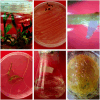Piriformospora indica culture filtrate and cell extract induce chicoric acid production in Echinacea purpurea hairy roots
- PMID: 40526612
- PMCID: PMC12173382
- DOI: 10.1371/journal.pone.0323961
Piriformospora indica culture filtrate and cell extract induce chicoric acid production in Echinacea purpurea hairy roots
Abstract
Echinacea purpurea (L.) Moench, commonly known as purple coneflower, is a significant medicinal plant renowned for its therapeutic properties, which are attributed to various phytochemical compounds, including caffeic acid derivatives (CADs). Chicoric acid is one of the CADs that has important immunostimulatory properties. This study employed a hairy roots (HRs) culture and an elicitation system to enhance the production of chicoric acid in E. purpurea. HRs cultures were established, and different concentrations (0, 1.25, 2.5, 5, and 10% v/v) of elicitors derived from Piriformospora indica culture filtrate (CF) and cell extract (CE) were added at two time points during the HRs growth period (on days 24 and 26). The effects of these treatments on the growth of HRs, chicoric acid production, and the expression of genes involved in the chicoric acid biosynthesis pathway were investigated. The highest dry weight of HRs (2.19 g/L, 1.36% higher than that in the control) was achieved in the HRs culture treated with 5% CF on the 24th day. In contrast, 5 and 10% (v/v) of P. indica CE, regardless of addition time, significantly decreased HRs growth compared to the control. The maximum production of chicoric acid (15.52 mg/g DW) was recorded after 48 h in the HRs culture treated with 5% CE on day 24, representing a 2.6-fold increase compared to the control (5.95 mg/g DW). Additionally, adding 2.5% CF to the HRs culture on day 26 resulted in a 2.3-fold increase compared to the control (13.5 mg/g DW) in chicoric acid biosynthesis. Real-time PCR assays revealed that the expression levels of the genes PAL, C4H, 4CL, C3H, and HCT were significantly upregulated after 3 and 12 h of elicitation with CE and CF. The highest gene expression was recorded for the C4H and PAL genes, 3 h after elicitation by CE (29.64 and 26.2-fold increases compared to the control culture). In contrast, the expressions of the 4CL and C3H genes peaked 12 h after elicitation with CF. The expression of the HCT gene also reached its highest level after 12 h of CE elicitation. Consistent with the chicoric acid production results, CE was found to be a more effective elicitor for inducing gene expression in the chicoric acid biosynthesis pathway. Overall, these findings indicate that HRs cultures and elicitors derived from P. indica are promising strategies to enhance chicoric acid production in E. purpurea (L.).
Copyright: © 2025 Khalili et al. This is an open access article distributed under the terms of the Creative Commons Attribution License, which permits unrestricted use, distribution, and reproduction in any medium, provided the original author and source are credited.
Conflict of interest statement
The authors have declared that no competing interests exist.
Figures





Similar articles
-
Oral toxicity and genotoxicity assessment of standardized Echinacea purpurea (L.) extract and the pharmacokinetic profile of its active ingredient chicoric acid.Toxicol Res. 2024 May 10;40(3):457-472. doi: 10.1007/s43188-024-00238-z. eCollection 2024 Jul. Toxicol Res. 2024. PMID: 39678074 Free PMC article.
-
Heterologous expression of an acid phosphatase gene and phosphate limitation leads to substantial production of chicoric acid in Echinacea purpurea transgenic hairy roots.Planta. 2019 Dec 10;251(1):31. doi: 10.1007/s00425-019-03317-w. Planta. 2019. PMID: 31823013
-
Surveillance for Violent Deaths - National Violent Death Reporting System, 50 States, the District of Columbia, and Puerto Rico, 2022.MMWR Surveill Summ. 2025 Jun 12;74(5):1-42. doi: 10.15585/mmwr.ss7405a1. MMWR Surveill Summ. 2025. PMID: 40493548 Free PMC article.
-
Biological potential and therapeutic effectiveness with diverse signaling pathways of phyto-product chicoric acid: a comprehensive review with computational evidence.Naunyn Schmiedebergs Arch Pharmacol. 2025 Jul;398(7):8259-8286. doi: 10.1007/s00210-025-03931-4. Epub 2025 Feb 27. Naunyn Schmiedebergs Arch Pharmacol. 2025. PMID: 40014130 Review.
-
Prevalence and odds of anxiety and depression in cutaneous malignant melanoma: a proportional meta-analysis and regression.Br J Dermatol. 2024 Jun 20;191(1):24-35. doi: 10.1093/bjd/ljae011. Br J Dermatol. 2024. PMID: 38197404
References
-
- Murthy HN, Lee E-J, Paek K-Y. Production of secondary metabolites from cell and organ cultures: strategies and approaches for biomass improvement and metabolite accumulation. Plant Cell Tiss Organ Cult. 2014;118(1):1–16. doi: 10.1007/s11240-014-0467-7 - DOI
-
- Lema-Rumińska J, Kulus D, Tymoszuk A, Varejão JMTB, Bahcevandziev K. Profile of secondary metabolites and genetic stability analysis in new lines of Echinacea purpurea (L.) Moench micropropagated via somatic embryogenesis. Ind Crops Prod. 2019;142:111851. doi: 10.1016/j.indcrop.2019.111851 - DOI
-
- Gupta M, Sharma D, Sharma A, Kumari V, Goshain O. A review on purple coneflower (Echinacea purpurea L. Moench). J Pharm Res. 2012;5(8):4076–81.
MeSH terms
Substances
LinkOut - more resources
Full Text Sources

